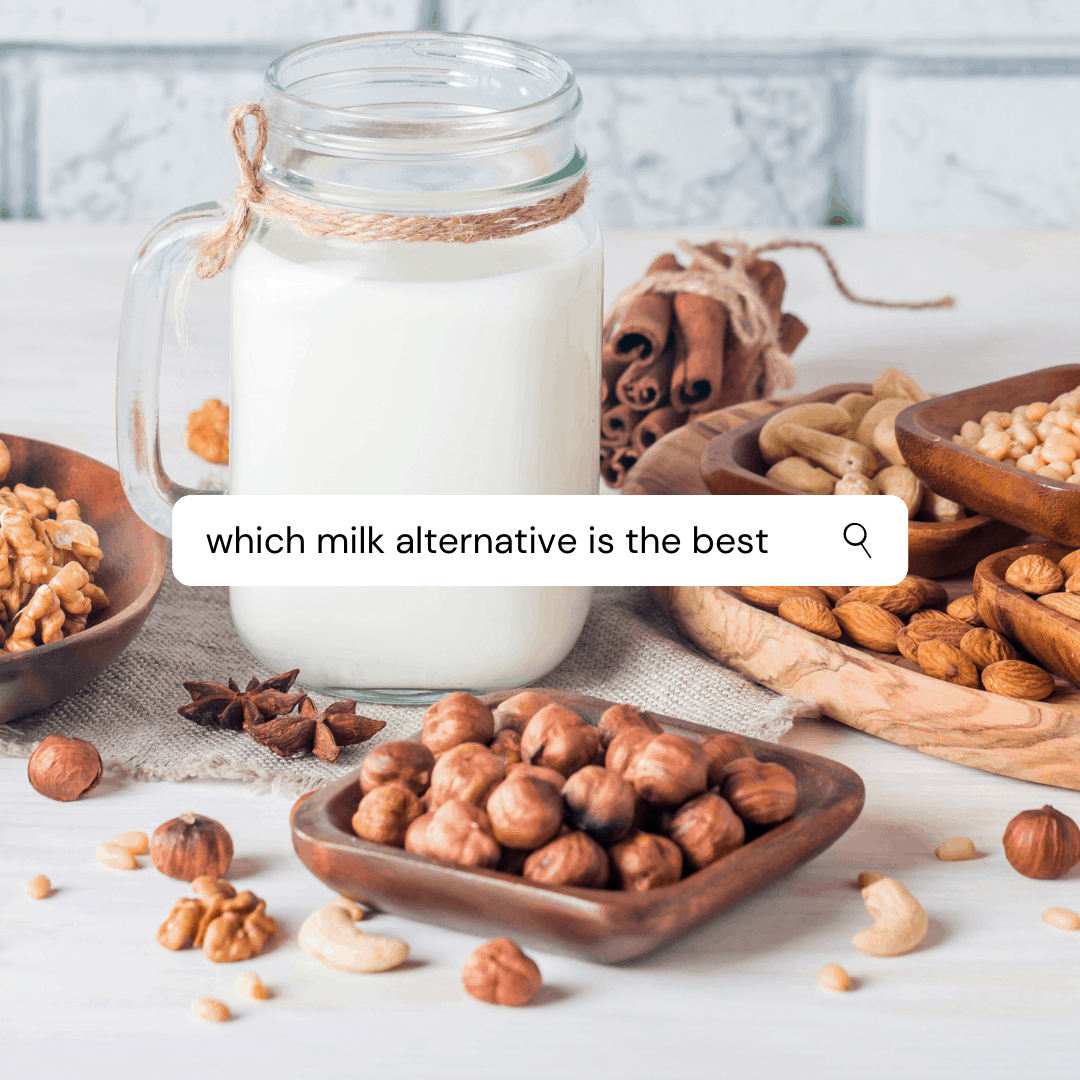
Alternative milk, such as soy, almond, oat, and coconut milk, has grown in popularity in recent years due to its many sustainability advantages over regular dairy milk. Dairy milk production consumes a substantial amount of resources, including water, land, and energy, while also contributing to greenhouse gas emissions, animal welfare concerns, and water pollution.
Lowering greenhouse gas emissions is one of the primary sustainability benefits of alternative milk. Alternative milk production often produces lower greenhouse gas emissions than dairy milk production. Almond milk, for example, has a substantially smaller carbon footprint than dairy milk, owing to decreased methane emissions from cows, which is a strong greenhouse gas. Moreover, plant-based milk production takes less water than dairy milk production, and the water utilized is often less polluted.
Another advantage of alternative milk for sustainability is the reduction in land utilization. Dairy production necessitates a considerable quantity of land, which can result in deforestation and soil deterioration. Plant-based milk, on the other hand, may be produced on considerably less area, minimizing agriculture’s environmental effect. This is especially true for nut milk like almond and cashew milk, which may be produced on trees that take up less area than a cow pasture.
Additionally, alternative milk can address animal welfare issues connected with traditional dairy production. Cows on typical dairy farms are frequently confined in limited places, and their health may suffer as a result of forced breeding and milk output. Customers may support a more compassionate approach to food production and limit their commitment to animal suffering by purchasing plant-based milk.
Alternative milk has significant environmental advantages over regular dairy milk. Consumers may lessen their environmental impact, promote animal welfare, and contribute to a more sustainable food system by selecting plant-based milk.
How To Choose The Most Sustainable Milk
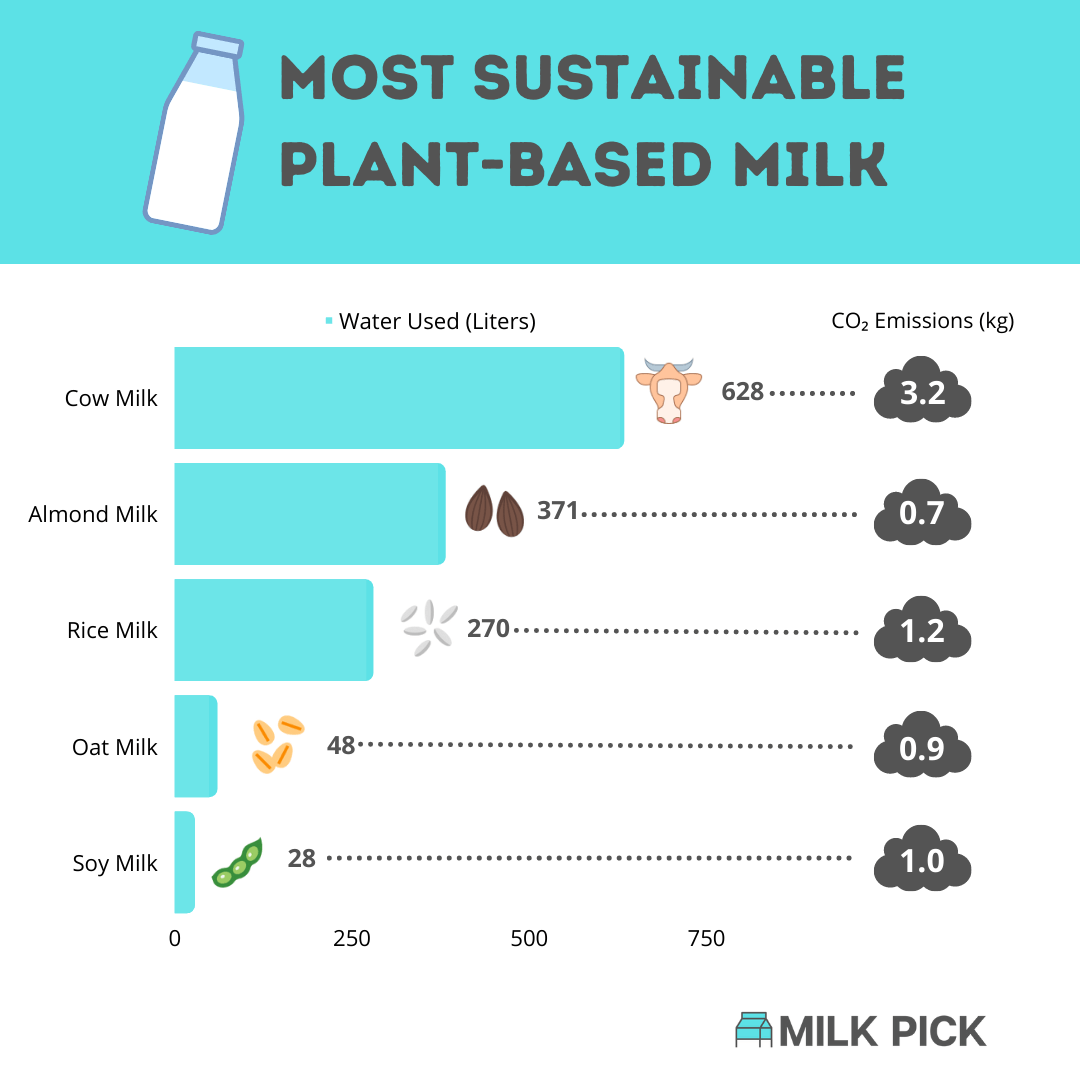
Choosing the most sustainable milk can be a complex process, as it involves considering various factors such as environmental impact, animal welfare, and health benefits. Here are some tips to help you choose the most sustainable milk:
Consider the environmental impact: As mentioned earlier, dairy milk production has a significant environmental impact, so choosing an alternative milk with a lower carbon footprint and water usage is a good option. Almond, oat, and soy milk have lower environmental impacts than cow’s milk, but it’s essential to check the production methods and sourcing of these products to ensure they are sustainable.
Look for organic or grass-fed options: If you choose to consume dairy milk, look for organic or grass-fed options. Organic dairy farming practices tend to be more sustainable and reduce the use of pesticides and other harmful chemicals. Grass-fed dairy cows also tend to have a lower carbon footprint than those fed on grains.
Check the packaging: Choose milk that comes in recyclable or reusable packaging. Plastic packaging has a significant impact on the environment, so choosing glass bottles or cartons is a better option.
Support local producers: Choosing milk produced by local farmers reduces the environmental impact associated with transportation and supports local agriculture. It’s also a good way to ensure that the milk is fresh and produced using sustainable methods.
Consider plant-based options: Plant-based milk such as soy, oat, and almond milk have lower environmental impacts than dairy milk, but it’s essential to check the production methods and sourcing of these products to ensure they are sustainable.
Therefore, selecting the most sustainable milk necessitates a deliberate effort to analyze numerous elements such as environmental effects, animal welfare, and health advantages. By considering these criteria, you can make a more educated selection and select milk that resonates with your beliefs and promotes a more sustainable food system.
Final Thoughts On Which Plant Milk Is The Most Sustainable
While each plant-based milk has its own sustainability benefits, it is challenging to determine which one is the most sustainable. Several factors, such as water usage, land use, and carbon footprint, vary significantly depending on the production methods and sourcing of each product.
However, some studies suggest that oat milk may be one of the most sustainable plant-based milk options. Oats require less water and land than almonds, and oat milk production generates fewer greenhouse gas emissions than soy milk. Additionally, oats are often grown in areas that are not suitable for food production, making use of land that would otherwise go unused.
which alternative milk is the most sustainable?
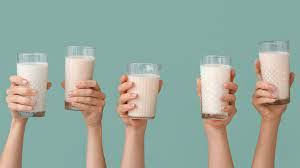
It is challenging to determine which alternative milk is the most sustainable as each one has its own sustainability benefits and challenges. However, some plant-based milk is generally considered more sustainable than others.
Oat milk is often considered one of the most sustainable alternatives due to its relatively low environmental impact. Oats require less water and land than some other milk alternatives, and oat milk production generates fewer greenhouse gas emissions than soy milk.
Additionally, oat milk can be produced using more sustainable farming practices, such as organic and regenerative agriculture, which reduces the use of harmful chemicals and supports soil health.
Another sustainable milk alternative is hemp milk. Hemp requires less water and land than many other crops, and the plant itself is highly resilient, making it an ideal crop for sustainable farming practices. Hemp milk is also rich in nutrients and has a creamy texture that makes it a popular choice for many consumers.
Soy milk is another sustainable milk alternative, as it requires less water than almond milk and has a relatively low carbon footprint. However, soy farming practices can have negative environmental impacts, such as deforestation in areas where soy is grown.
Sustainable plant-based milk brands
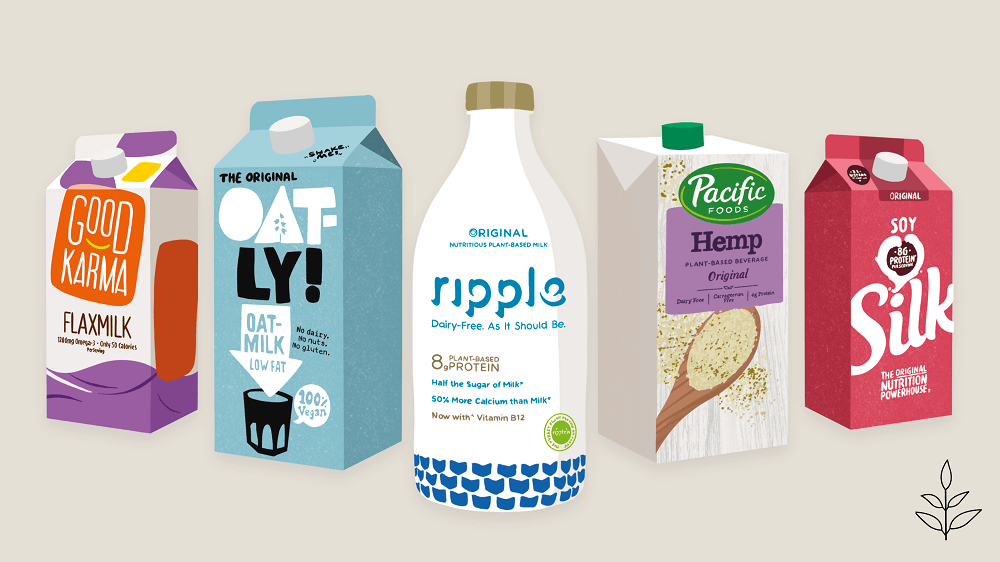
Oatly Oat Milk is a plant-based milk made from oats. It is produced by blending oats with water, then separating the oat solids from the liquid. The resulting milk is naturally sweet and creamy, making it a popular choice for those seeking a dairy-free milk alternative. Oatly Oat Milk is known for its sustainability practices and commitment to reducing the environmental impact of food production.
Ripple Pea Milk is a plant-based milk alternative made from peas. It is produced by blending peas with water, then separating the pea solids from the liquid. Ripple Pea Milk is rich in protein, calcium, and other nutrients, making it a popular choice for those seeking a more nutritious milk alternative. It is also known for its sustainability practices, as pea farming requires less water and produces fewer greenhouse gas emissions than some other crops.
Shop Ripple Pea Milk is a phrase used to encourage consumers to purchase Ripple Pea Milk from a particular retailer or online store. It is a marketing technique used to increase awareness of the product and drive sales. By providing a direct link or information on where to find Ripple Pea Milk, the phrase encourages consumers to make a purchase and try the product.
The Full List Of Which Milk Is The Most Sustainable?
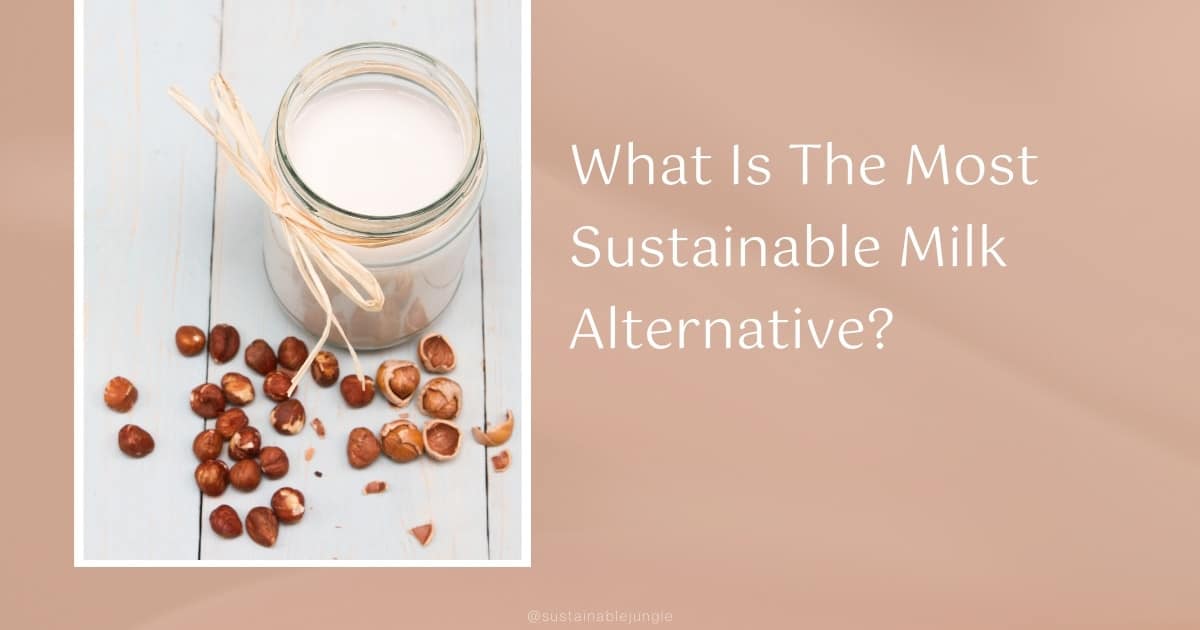
Almond Milk is a plant-based milk made by blending almonds with water, then straining the mixture to remove the solids. It is known for its nutty flavor and is a popular dairy-free milk alternative.
Cashew Milk is a plant-based milk made by blending cashews with water, then straining the mixture to remove the solids. It has a creamy texture and a slightly sweet, nutty flavor.
Coconut Milk is plant-based milk made from the flesh of coconuts. It is produced by blending coconut flesh with water, then straining the mixture to remove the solids. Coconut milk has a rich, creamy texture and is often used in cooking and baking.
Hazelnut Milk is a plant-based milk made by blending hazelnuts with water, then straining the mixture to remove the solids. It has a rich, nutty flavor and is often used in coffee or as a dairy-free milk alternative.
Hemp Milk is a plant-based milk made from the seeds of the hemp plant. It is produced by blending hemp seeds with water, then straining the mixture to remove the solids. Hemp milk has a slightly nutty flavor and is a good source of protein and omega-3 fatty acids.
Flax Milk is a plant-based milk made from flax seeds. It is produced by blending flax seeds with water, then straining the mixture to remove the solids. Flax milk has a slightly nutty flavor and is a good source of omega-3 fatty acids.
Oat Milk is a plant-based milk made from oats. It is produced by blending oats with water, then straining the mixture to remove the solids. Oat milk has a creamy texture and is a good source of fiber.
Pea Milk is a plant-based milk made from yellow peas. It is produced by blending peas with water, then straining the mixture to remove the solids. Pea milk is a good source of protein and is often used as a dairy-free milk alternative.
Potato Milk is a plant-based milk made from potatoes. It is produced by blending potatoes with water, then straining the mixture to remove the solids. Potato milk has a mild flavor and is often used as a dairy-free milk alternative in recipes.
Rice Milk is a plant-based milk made from rice. It is produced by blending rice with water, then straining the mixture to remove the solids. Rice milk has a mild, slightly sweet flavor and is often used as a dairy-free milk alternative in recipes.
Soy Milk is a plant-based milk alternative made from whole soybeans or soy protein isolate and water. The process of making soy milk involves soaking, grinding, and boiling the soybeans with water, then filtering the mixture to remove the solid residue. Soy milk is a popular choice for people who are lactose intolerant or allergic to dairy and other plant-based milk.
Soy milk is considered to be one of the most nutritionally balanced plant-based milk alternatives as it contains a similar amount of protein as cow’s milk. It is also a good source of calcium, vitamin D, and other essential nutrients. Soy milk is a versatile milk alternative
Why soy is not the best plant-based milk alternative for the environment
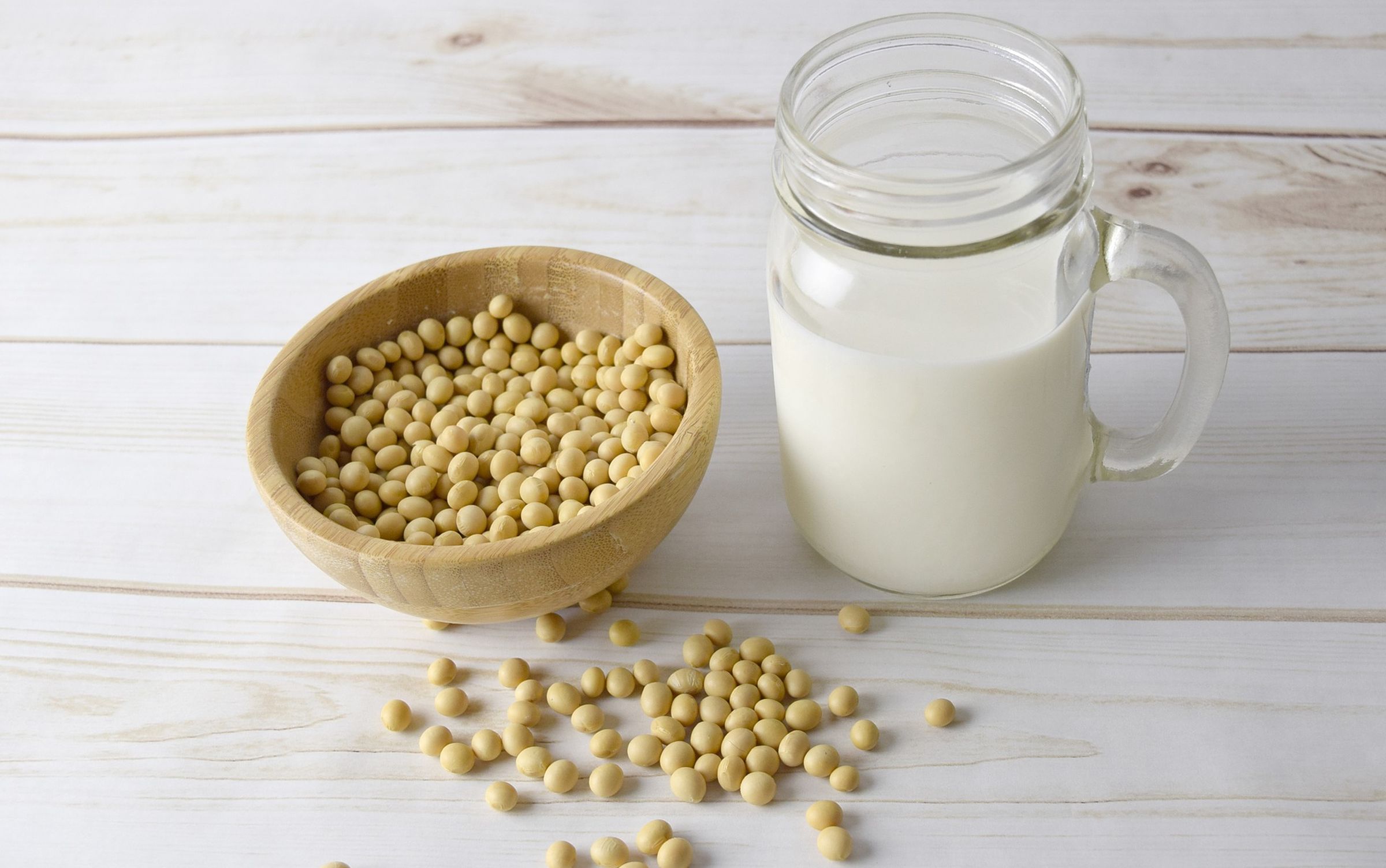
While soy milk is a popular and nutritious plant-based milk alternative, it is not always considered the best choice for the environment. Here are some reasons why:
Land use: Soybeans are a crop that requires a significant amount of land to grow, leading to concerns over deforestation and habitat destruction. In some regions, such as South America, soybean farming has been linked to the deforestation of important ecosystems like the Amazon rainforest.
Water use: Soybeans require a significant amount of water to grow, which can put pressure on water resources in areas that already face water scarcity. In some regions, such as the Midwestern United States, soybean farming has been linked to the depletion of water resources and contamination of waterways from agricultural runoff.
Monoculture: Soybeans are often grown in monoculture, which can lead to a loss of biodiversity and increase the risk of pests and diseases.
Genetic modification: The majority of soybeans grown globally are genetically modified, which raises concerns over potential environmental impacts and the use of herbicides and pesticides.
Soy milk can be a nutritious and sustainable choice when produced using environmentally friendly farming practices, but there are concerns over the environmental impact of large-scale soybean farming. As a result, it may be worth considering other plant-based milk alternatives that have a lower environmental footprint, such as oat milk, pea milk, and hemp milk.
How does organic milk affect the environment compared to regular milk?
Organic milk is produced using farming practices that are designed to be more environmentally sustainable than conventional milk production methods. Organic farmers do not use synthetic fertilizers or pesticides, which can harm soil quality, water quality, and wildlife. Instead, organic farmers rely on natural methods like crop rotation and composting to maintain soil health and control pests.
Compared to regular milk production methods, organic milk production has a lower environmental impact in several ways:
Reduced Water Pollution: Organic farmers do not use synthetic fertilizers and pesticides, which can contaminate groundwater and surface water, leading to water pollution. By using natural methods to manage pests and maintain soil health, organic farmers can help reduce water pollution.
Reduced Greenhouse Gas Emissions: Organic farming practices tend to use less energy and produce fewer greenhouse gas emissions than conventional farming practices. For example, organic farmers may use more manual labor and rely less on heavy machinery, which can reduce emissions.
Enhanced Biodiversity: Organic farming practices can help enhance biodiversity by providing habitat for a range of plants and animals. By avoiding synthetic fertilizers and pesticides, organic farmers can help support pollinators and other beneficial insects.
Improved Soil Quality: Organic farming practices tend to promote soil health and fertility, which can reduce erosion and help retain water in the soil. This can help mitigate the impacts of drought and flooding and reduce the need for irrigation.
Overall, organic milk production can have a lower environmental impact than conventional milk production methods. However, it’s important to note that organic milk production still requires resources and can contribute to environmental impacts like land use, transportation emissions, and water use.
What are the disadvantages of plant-based milk?
While plant-based milk is often touted as a healthier and more environmentally friendly alternative to dairy milk, there are some potential disadvantages to consider:
Lower Nutrient Content: Plant-based milk often has lower nutrient content than dairy milk, especially when it comes to protein and calcium. While some plant-based milk is fortified with these nutrients, they may still not be as nutritionally complete as dairy milk.
Allergies or Sensitivities: Some people may be allergic or sensitive to the ingredients used to make plant-based milk, such as soy, nuts, or gluten. This can limit their options when it comes to choosing alternative milk products.
Additives and Processing: Many plant-based kinds of milk contain additives like thickeners, stabilizers, and sweeteners to improve their taste and texture. Additionally, some plant-based milk is heavily processed, which can reduce its nutritional value and increase its environmental impact.
Availability and Cost: Plant-based milk can be more expensive and less widely available than dairy milk, especially in certain parts of the world. This can make it difficult for some consumers to switch to plant-based milk.
Environmental Impact: While plant-based milk is often touted as a more sustainable alternative to dairy milk, some types of plant-based milk require significant amounts of water, energy, and other resources to produce. Additionally, the production of some plant-based milk can have negative impacts on soil quality, water quality, and biodiversity
Overall, plant-based milk can be a healthy and sustainable alternative to dairy milk for many people, but it’s important to consider the potential disadvantages and choose the option that works best for your needs and values.
How dairy milk has improved its environmental and climate impact?
The dairy industry has been working to improve its environmental and climate impact in several ways:
- Reducing greenhouse gas emissions: Many dairy farms are implementing practices to reduce greenhouse gas emissions from their operations, such as capturing and utilizing methane gas from manure and implementing feed management practices to reduce the amount of methane produced by cows.
- Improving energy efficiency: Dairy farms are implementing energy-saving technologies, such as LED lighting and energy-efficient cooling systems, to reduce their energy use and associated greenhouse gas emissions.
- Sustainable feed production: The dairy industry is working to reduce the environmental impact of feed production by using sustainable practices such as conservation tillage, cover cropping, and precision agriculture.
- Water management: The dairy industry is implementing practices to reduce water use and improve water quality, such as utilizing recycled water for irrigation and implementing nutrient management plans to minimize nutrient runoff.
- Alternative energy sources: Some dairy farms are implementing renewable energy sources, such as solar or wind power, to reduce their greenhouse gas emissions and energy costs.
- Animal welfare: The dairy industry is adopting practices to improve animal welfare, such as providing cows with more space and access to outdoor areas, which can improve their health and reduce their environmental impact.
While the dairy industry has made progress in improving its environmental and climate impact, there is still much work to be done to address the environmental challenges associated with dairy farming.
What are examples of environmental factors that affect stress in dairy production?
There are several environmental factors that can affect stress in dairy production, including:
Temperature: High temperatures can cause heat stress in dairy cows, leading to decreased milk production and fertility, as well as increased health problems. Conversely, low temperatures can also cause stress, particularly if cows are not adequately protected from cold and wind.
Humidity: High humidity can exacerbate the effects of high temperatures on cows, leading to further heat stress.
Ventilation: Poor ventilation in barns and other facilities can lead to increased humidity and heat stress, as well as respiratory problems.
Lighting: Cows require a certain amount of light each day to maintain their health and reproductive cycles. Inadequate or irregular lighting can cause stress and health problems.
Noise: Loud or unexpected noises can cause stress in dairy cows, particularly during milking.
Handling and social interactions: Poor handling practices or inadequate social interactions can cause stress in dairy cows and lead to decreased milk production and other health problems.
Feed quality and availability: Inadequate or inconsistent feed can cause stress and health problems in dairy cows, as well as decreased milk production.
Water availability and quality: Inadequate or poor-quality water can cause stress and health problems in dairy cows, particularly during times of high heat and humidity.
Pest and disease control: Inadequate pest and disease control can cause stress and health problems in dairy cows, as well as decreased milk production and reproductive problems.
Leave a Reply